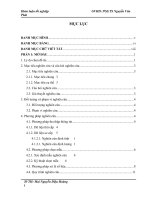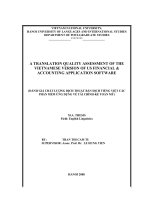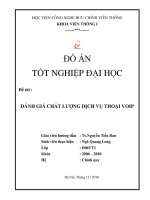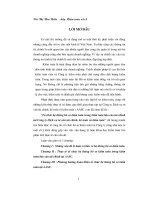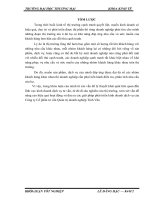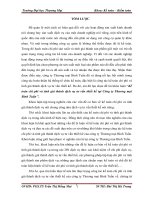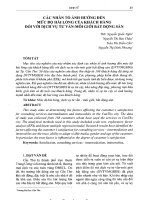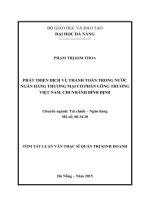Đánh giá công cụ marketing cho dịch vụ tư vấn du học ở hà nội
Bạn đang xem bản rút gọn của tài liệu. Xem và tải ngay bản đầy đủ của tài liệu tại đây (502.18 KB, 18 trang )
Đánh giá công cu ̣ marketing cho dich
̣ vu ̣ tư vấ n
du ho ̣c ở Hà Nô ̣i
Đậu Thu Hương
Đại học Quốc gia Hà Nội
Chuyên ngành: Quản trị kinh doanh; Mã số: 60 34 05
Người hướng dẫn: TS. Nguyễn Thi Phi Nga; ThS. Hà Nguyên
Năm bảo vệ: 2012
Abstract: Chapter 1: A theoretical background of service marketing, marketing in
education and marketing in overseas education service. Chapter 2: An evaluation of
marketing and promotion activities of overseas education consultants in Hanoi. Chapter
3: Solutions to improving the effectiveness of marketing and promotion activities of
overseas education consultants in Hanoi
Keywords: Quản trị kinh doanh; Marketing; Dịch vụ; Tư vấn du học; Quản lý tiếp thị
Content
TABLE OF CONTENT
ACKNOWLEDGEMENTS ...................................................................................... i
ABSTRACT .............................................................................................................. ii
TÓM TẮT ................................................................................................................ iii
TABLE OF CONTENT .......................................................................................... iv
LIST OF FIGURES ............................................................................................... vii
LIST OF ABBREVIATIONS............................................................................... viii
INTRODUCTION .....................................................................................................1
1. Rationale .................................................................................................................1
2. Objectives of the study ............................................................................................2
3. Scopes of the study..................................................................................................2
4. Methodology of the study .......................................................................................3
5. Structure of the study ..............................................................................................3
CHAPTER
1:
A
THEORETICAL
BACKGROUND
OF
SERVICE
MARKETING, MARKETING IN EDUCATION, AND MARKETING IN
OVERSEAS EDUCATION SERVICE ...................................................................5
A . OVERVIEW OF OVERSEAS STUDY OF VIETAM ...................................5
B. THEORETICAL BACKGROUND ....................................................................7
1.1. An overview of service marketing ....................................................................7
1.1.1. Concept of service marketing............................................................................8
1.1.2. Fundamentals of service marketing ................................................................11
1.2. An overview of marketing in overseas education services ...........................25
1.2.1. International Education services .....................................................................25
1.2.2. Marketing in international education ..............................................................26
1.2.3. Education agents .............................................................................................27
1.2.4. The role of agents ...........................................................................................29
1.3. Marketing communication: Channels and promotion tools ........................31
1.4. Typical marketing tools used by OSC……………………………… ……... 36
1.5. Proposed model ..................................................................................................47
iv
CHAPTER 2: EVALUATION OF
MARKETING ACTIVITIES OF
OVERSEAS STUDY CONSULTANTS IN HANOI............................................49
2.1. Analysis of marketing activities of overseas education consultants in Hanoi
........................................................................................................................50
2.1.2. Evaluation of the frequency use of each marketing tool employed by
overseas study consultants ........................................................................................51
2.1.3. Evaluation of marketing tools from the perspective of overseas study
consultants .................................................................................................................54
2.2. Evaluation of marketing tools used by overseas education consultants from
students' perspective ...............................................................................................56
2.2.1. Evaluation of the most popular marketing tools .............................................56
2.2.2. Evaluation of most expected/ chosen marketing tools ....................................58
2.2.3. Comparison between the level of actual use and selection / expectation of
students of oversea study marketing tools ................................................................59
2.3. Comparison of perceptions of the effectiveness of marketing promotion
tools hold by students and overseas study consultants ......................................61
2.4. Evaluation of marketing activities by each marketing tool .........................63
2.4.1. Evaluation of each marketing tool ..................................................................64
2.4.2. Evaluation of OSC by tools.................................................................................
65
CHAPTER 3: SOLUTIONS TO IMPROVING MARKETING ACTIVITIES
OF OVERSEAS STUDY CONSULTANTS .........................................................71
3.1. General solution for Groups of marketing tools for overseas education
consultancy service ..................................................................................................76
3.1.1. Solution for Group 1 .......................................................................................71
3.1.2. Solutions for Group 2 .....................................................................................72
3.1.3. Solutions for Group 4 .....................................................................................73
3.2. Specific solutions for each marketing tool .....................................................75
3.2.1. A solution to Tool 1- Direct mail ................................................................... 80
v
3.2.2. Solution for Tool 2 - Advertising ..................................................................75
3.2.3. Solutions for Tool 3 – Education fairs ...........................................................77
3.2.4. Solution for Tool 4 - Direct consultancy and recruitment .............................80
3.2.5.Solution for Tool 5 – Websites ........................................................................80
3.2.6. Solution for Tool 6 - Banner advertising .......................................................82
3.2.7.Solution for Tool 7 – Listings ..........................................................................84
3.2.8. Solution for Tool 8 – Email marketing ..........................................................84
3.2.9. Solution for Tool 9 - Seminars .......................................................................85
3.2.10. Solution for Tool 10 - Pr ...............................................................................86
3.2.11. Solution for Tool 11 – Tele marketing..........................................................87
3.3. Expansion and renovation of other types of marketing tools ......................90
3.3.1. Street banner advertising ............................................................................... 96
3.3.2. Introduction to friends, relatives, acquaintances (words of mouth advertising).....90
3.3.3. Old customer care ...........................................................................................91
3.3.4. Overseas study links ........................................................................................92
3.3.6. English center ..................................................................................................92
CONCLUSIONS .....................................................................................................94
REFERENCES ........................................................................................................96
APPENDIX ............................................................................................................110
vi
REFERENCES
[1]
ACIIC (1993), Innovation In Australia’s Service Industries, Australian
Centre for Innovation and International Competitiveness, University of
Sydney, Department of Industry, Technology and Commerce, AGPS,
Canberra.
[2]
AGB (1992), International Competitiveness Study, Education Information
and Publication IDP Ltd, Canberra.
[3]
Akchin, D. (2001), Non-profit Marketing: Just How Far Has It Come?
Non-profit World, Jan/Feb, Vol. 19 No. 1, pp. 33 – 35.
[4]
Alexander, J. A., and Weiner, B. J. (1998), The Adoption of the Corporate
Governance Model by Nonprofit Organizations, Nonprofit Management
and Leadership, Vol. 8 No. 3, pp. 223 –242.
[5]
Altbach, P. G., Knight, J. 2006. The Internationalization of Higher
education: Motivations and Realities. The NEA 2006 Almanac of Higher
Education, 1-11.
[6]
Andreasen, A. R., and Kotler, P. (2003), Strategic Marketing for Non-profit
Organizations (6th ed.)”, Upper Saddle River, NJ: Prentice Hall.
[7]
Armstrong, J. J. (1997). Factors influencing freshmen students' college
choice at the University of North Texas: a focus group study. (Doctoral
dissertation, university of north Texas, 1997). Dissertation Abstracts
International, 58, 07a, 2555.
[8]
Australian Government, Australian Taxation Office (ATO). (2007), Nonprofit
Organizations,
Retrieved
/>
96
November,
2007,
from
[9]
Bennel, P. & Pearce, T. (2003). The Internationalization of Higher
Education: exporting education to developing and transitional economies.
International Journal of Educational Development, 23, 215-232
[10] Berry, L.L. (1980), Service marketing is different, business, vol. 30 pp. 249.
[11] Berry, L.L., Parasuraman, A. (1993), Building a new academic field - the
case of services marketing, Journal of Retailing, vol. 69 no.1, pp.13-60.
[12] Bingham, F. (1989). Promotion: An inseparable part of the marketing
effort. Journal of marketing for higher education. 1(2), 15-26.
[13] Blackburn, J. C. (1979). Marketing techniques used by admissions officers
(doctoral dissertation, Indiana University, 1979). Dissertation abstracts
international, 40, 08a, 4428.
[14] Blois, K.J. (1974), The marketing of services: an approach, European
journal of marketing, vol. 8 pp.137-45.
[15] Blythe, Jim (2008). Essentials of Marketing (4th ed.). Pearson Education.
[16] Booms,
B.h.,
Nyquist,
J.
(1981),
Analysing
the
customer/firm
communication component of the service marketing mix, in Donnelly,
[17] Brennan, l., & Bennington, l. (1999). Concepts in conflict: students and
customers - An Australian perspective. Journal of marketing for higher
education, 9(2), 19-40.
[18] Brim, O.g., Wheeler, S. (1966), Socialization after childhood: two essays,
john Wiley and sons, New York, NY.
[19] Bruce, I. (1995), Do not-for-profits value their customers and their needs?
International Marketing Review, Vol. 12 No. 4, pp. 77 – 84.
[20] Clark, D. (ed.) (1988), The services sector, in student economic briefs (eds),
1988/89, the financial review library, Sydney, pp.60-8.
97
[21] Coats, S. (1989). Exhibiting at conferences, conventions and trade shows.
Handbook of marketing for continuing education (p. 330-341). San
Francisco, ca: Jossey bass.
[22] Cohen, W. A. (1991). The practices of marketing management: analysis,
planning, and implementation (2nd ed.). NY: Macmillan Publishing
Company.
[23] Cope, R., & Delaney, g. (1991). Academic program review: a market
strategy perspective. In T.j. Hayes (eds.), new strategies in higher education
marketing (pp. 63-86). Binghamton, NY: Haworth press, Inc.
[24] Craven, R. F., & Duhamel, m. b. (2000). Marketing realities in continuing
professional education. New directions for adult and continuing education,
86, 55-62.
[25] Day, G. S. (1994), The Capabilities of Market-Driven Organizations,
Journal of Marketing, Vol. 58 No. 4, pp. 37 – 52.
[26] DCT (1993), Industry marketing strategy: department of commerce and
trade international trade in professional services, May, department of
commerce.
[27] Dearden, J. (1978), Cost accounting comes to service industries, Harvard
business review, vol. 56 pp.132-40.
[28] DEET (1993), Review of Australian education centers, department of
employment, education and training, Canberra, vol. 2.
[29] Dill, D. d., & Sporn, B. (1995). The implications of a postindustrial
environment for the university: an introduction. In D. dill & B. Sporn
(eds.), emerging patterns of social demand and university reform: through a
glass darkly (pp. 1-19). NY: tau press.
[30] Dolnicar, S., Irvine, H. and Lazarevski K. (2008), Mission or Money?
Competitive challenges facing public sector nonprofit organizations in an
98
institutionalized environment, International Journal of Nonprofit and
Voluntary Sector Marketing, Vol. 13, pp. 107 – 117.
[31] Driscoll, C., & Wicks, d. (1998, September/October). The customer-driven
approach in business education: a possible danger? Journal of education
for business, 74(1), 58-61.
[32] Dunning, J.H., Kundu, S.K. (1995), The internationalization of the hotel
industry - some new findings from a field study, Management International
Review, vol. 35 no.2, pp.101-33.
[33] Ebrahim, A. (2003), Making sense of accountability: Conceptual
perspectives
for
northern
and
southern
non-profits,
Non-profit
Management and Leadership, Vol. 14 No. 2, pp. 191 – 212.
[34] Eikenberry, A. M., and Kluver, J. D. (2004), The Marketization of the Nonprofit Sector: Civil Society at Risk? Public Administration Review, Vol. 64
No. 2, pp. 132-140.
[35] Elliottt, R. (1989). Handbook of marketing for continuing education (p.
141). San Francisco, ca: Jossey-Bass.
[36] Evans, K.e. (1995), Educational services as a national industry, in Davis,
T.m. (eds), open doors 1994/95: report on international educational
exchange, institute of international education, New York, NY, pp.117-18.
[37] Farlow, H. (1979). Publicizing and promoting programs. New York, NY:
McGraw-Hill Book Company.
[38] Fisk, R.P., Brown, S.W., Bitner, M.J. (1993), Tracking the evolution of the
services marketing literature, Journal of Retailing, vol. 69 no.1, pp.61-103.
[39] Fong, J. (2000). The state of marketing. (PowerPoint presentation made at
Ucea marketing seminar, February 19, 2000).
99
[40] Foskett, N. H., Hemsley-Brown, J. V. 2001. Choosing Futures: Young
People's Decision-making in Education, Training and Careers Markets.
Routledge/Falmer, London.
[41] Gallagher, K., and Weinberg, C. B. (1991), Coping with Success: New
Challenges for Non-profit
[42] George, W.R. (1977), The retailing of services: a challenging future,
Journal of Retailing, vol. 53 pp.85-98.
[43] Goerke, J. (2003), Taking the quantum leap: Nonprofits are now in
business. An Australian perspective, Journal of Nonprofit and Voluntary
Sector Marketing, Vol. 8 No. 4, pp. 317 – 327.
[44] Goldgehn, l. a. (1982). A marketing opportunity analysis application of a
strategic marketing audit to higher education (doctoral dissertation,
northwestern university, 1982). Dissertation abstracts international, 43, 06a,
1850.
[45] Gomes l., Murphy j. (2003), An exploratory study of marketing
international education online, International journal of educational
management, volume 17 number 3 2003 pp. 116-125.
[46] Gonzalez, L. I. A., Vijande, M. L. S., and Casielles, R. V. (2002), The
market orientation concept in the private nonprofit organisation domain,
International Journal of Nonprofit and Voluntary Sector Marketing, Vol. 7
No. 1, pp. 55 – 67.
[47] Gray B. J., Fam k. s. and lianes v. a., (2003), Branding universities in Asian
markets, journal of product & brand management volume 12 number 2
2003 pp. 108-120.
[48] Gronroos, C. (1978), A service-oriented approach to marketing of services,
European journal of marketing, vol. 12 no.8, pp.588-601.
100
[49] Gronroos, C. 2000. Creating a relationship dialogue: communication,
interaction, value. The Marketing Review, 1, (1), 5-15.
[50] Hamer, G.A. (1993), The use of technology to deliver higher education in
the workplace, Agps, Canberra.
[51] Harris, D.r., Rhall, T.m. (1993), Survey of international students,
department of employment education and training, act, braddon.
[52] Hemsley-Brown, J., Oplatka, I. 2006. Universities in a competitive global
marketplace; a systematic review of the literature on higher education
marketing. The International Journal of Public Sector Management, 19, (4),
316-330.
[53] Holden, c. d. (1989). How every staff person can be a salesperson?
Handbook of marketing for continuing education (p. 309-319). San
Francisco, ca: Jossey-bass.
[54] )
[55] />[56] />n=search&name=du%20h%e1%bb%8dc
[57] />[58] />5005.
[59] . Service commitment-WTO accession for Vietnam
education services.
[60] Inglis, A., Ling., P&Jossten, V (1999) Delivering Digitally: Managing the
Transition to the New Knowlege Media, London: Routledge
101
[61] Japan Ministry of Education (2004a). Annual increase for self-paid
students in Japan hits 14,000. Retrieved January 23, 2005, from
/>[62] Japan Ministry of Education (2004b). School education - higher education.
Retrieved
December
15,
2004,
from
/>[63] Judd, R.C. (1968), Similarities or differences in products and service
retailing, journal of retailing, vol. 43 pp.1-9.
[64] Jugenheimer, D. W. (1995). Advertising the university: a professional
approach to promoting college or university. Journal of marketing for
higher education, 6(1), 1-22.
[65] Kara, A., Spillan, J E., and DeShields Jr, O. W. (2004), An Empirical
Investigation of the Link Between Market Orientation and Business
Performance in Non-profit Service Providers, Journal of Marketing Theory
and Practice, Vol. 12 No. 2, pp. 59 – 72
[66] Kinnell, M., & Macdougall, j. (1997). Marketing in the not-for-profit
sector, Jordan hill, Oxford: Butterworth- Heinemann, Linacre house.
[67] Kliebard, H. M. (1995). The struggle for the American curriculum (2nd
ed.). NY: Routledge.
[68] Knight, B., & Johnson, d. (1981). Marketing higher education. Educational,
62 (1), 28-31.
[69] Knight, J. (2002). Trade in higher education services: The implications of
GATS. Retrieved April 1, 2006, from />[70] Kotler, p. (1975). Marketing for nonprofit organizations. Prentice-hall, inc.,
Englewood cliffs, n. j.
102
[71] Kotler, P. (1979), Strategies for Introducing Marketing into Non-profit
Organizations, Journal of Marketing, Vol. 43 No. 1, pp. 37 – 44.
[72] Kotler, P. (1980). Principles of marketing. Englewood cliffs, n.j.: prenticehall.
[73] Kotler, P. (1982), Marketing for Non-profit Organizations (Second ed.),
New Jersey: Prentice- Hall.
[74] Kotler, P. (1982). Marketing for nonprofit organizations (2nd ed.).
Englewood cliffs, n.j.: prentice-hall, inc.
[75] Kotler, P. (2002), Basic marketing, Statistics Publishing House.
[76] Kotler, P., & Fox, K. (1995). Strategic marketing for educational
institutions (2nd ed.). Englewood cliffs, nj: prentice-hall, inc.
[77] Kotler, p., & Levy, S. J. (1969). Broadening the Concept of Marketing.
Journal of marketing. 33 (1), 10-15, 18.
[78] Kotler, P., and Levy, S. J. (1969), Broadening the Concept of Marketing,
Journal of Marketing, Vol. 33 No. 1, pp. 10 – 15.
[79] Krasocki, J. (2002), Education UK – developing the UK‘s international
education agent network, promotions and partnerships (ecs), the British
Council.
[80] Lek (1994), Intelligent exports: ―…and the silent revolution in services‖,
lek partnership, Australian trade commission, Sydney.
[81] Lenz, E. (1980). Creating and marketing programs in continuing education.
New York. NY: McGraw-hill Book Company.
[82] Li, L. M. & Chen Y. T. (2004). The disequilibrium flow of the Chinese
students in the internationalization of higher education. Comparison
Education Research China 2, 15-22.
103
[83] Litten, l.H. (1980). Marketing higher education: benefits and risks for the
American academic system. Journal of higher education, 51(1), 40-58.
[84] Liu, S. S. (1998). Integrating strategic marketing on an institutional level.
Journal of marketing for higher education, 8(4), 17-28.
[85] Liu, Y. (2005). New century: Developing directions of China education
service trade. China. Geology University Academic Journal 2, 22-25.
[86] Lovelock, C. (1983), Classifying services to gain strategic marketing
insights, Journal of marketing, vol. 47 pp. 9-20.
[87] Lynch, J. A. (1993), Managing the delight factory, ifs international, pp. 2527, 209-16.
[88] Macedo, I. M., and Pinho, J. C. (2006), The relationship between resource
dependence and market orientation, European Journal of Marketing, Vol.
40 No. 5/6, pp. 533 – 553.
[89] Mazzarol T., (1998), Critical success factors for international education
marketing, international journal of educational management volume 12
number 4 1998 pp. 163-175.
[90] Mazzarol, T. 1998. Critical success factors for international education
marketing. International Journal of Educational Management, 12, (4), 163175.
[91] Mazzarol, T., Kemp, s., Savery, l. (1996), A survey of international students
who choose not to study in Australia (Taiwan and Indonesia), Adelaide,
Australia, paper presented at the Australian international education
foundation 1996 business meeting.
[92] McDonald, C. (1999), Internal Control and Accountability in Non-profit
Human Service Organizations, Australian Journal of Public Administration,
Vol. 58 No. 1, pp. 11 – 22.
104
[93] Meyer, J. W., and Rowan, B. (1977), Institutionalized organizations:
formal structure as myth and ceremony, American Journal of Sociology,
Vol. 82 No. 2, pp. 340 – 363.
[94] Montana, P. J. (1978). Marketing in nonprofit organizations. New York:
Amacom.
[95] Morgan, N.A. (1991), Professional services marketing, ButterworthHeinemann, Oxford.
[96] MSS (1993), International education: the Asia pacific region and Canada,
minister of supply and services, Canada.
[97] Newberry, B. (1997). Designer‘s guide to marketing. Cincinnati: north light
books.
[98] Newman, F., & Couturier, l. K. (2001, September/October). The new
competitive arena: market forces invade the academy. Change, 33(5), 1047.
[99] Nghiem, Luu Van (2001) - A textbook of Service Marketing, Vietnam
National Economics University- Statistics Publishing House.
[100]Nicholls, j. (1987), Offshore education marketing: professional and
industrial issues, Australian universities review, vol. 29 no.2, pp.45-48.
[101]Nicholls, J., Harris, J., Morgan, E., Clarke, K., & Sims, D. (1995).
Marketing higher education: The MBA experience. International journal of
educational management, 9(2), 31-38.
[102] Oplatka, I., Hemsley-Brown, J. 2004. The research on school marketing:
current issues, future directions. Journal of Educational Administration, 42,
(3), 375-400.
[103] Padanyi, P., and Gainer, B. (2004), Market Orientation in the Nonprofit
Sector: Taking Multiple Constituencies into Consideration, Journal of
Marketing Theory and Practice, Vol. 12 No. 2, pp. 43 – 58.
105
[104] Pate, W. S. (1993, spring/summer). Consumer satisfaction, determinants,
and post-purchase actions in higher education: a model to guide academic
managers. college and university, 68(2), 100-107.
[105] Pawlowski, B. (2006), Tools for marketing your education outreach
programs, a Dehavilland market brief, Dehavilland associates, USA.
[106] Pelletier, S. G (1985, winter). Marketing higher education. Educational
horizons, 63(2), 54-60.
[107] Plunkert, l.M. (1990), The 1980s: a decade of job growth and industry
shifts, monthly labour review, vol. 113 pp.3-16.
[108] Rathmell, J.M. (1966), What is meant by services? Journal of marketing,
pp.32-6.
[109] Rea, P. J. (1989). Segmenting Ohio higher education student markets by
using act data (doctoral dissertation, university of Akron, 1989).
Dissertation abstracts international, 50, 06a, 1734.
[110] Research Group for International Education Service Trade (2002). The
latest development of the international education service trade. The
Research on Education Development 7-8, 13-14
[111] Rowe, P.W. (1995), "Western Australian services exports", inquiry into the
implications of Australia‘s exports of services to Indonesia and Hong Kong,
Canberra, joint standing committee on foreign affairs, defence and trade,
vol. 2 pp.380-468.
[112] Sang, J. L. (2003). The research on new trends and enlightenments of the
education service trade's development policies in Australia and New
Zealand. The Annual Research Report of Beijing's Education Development,
Vol. 2003, pp.381-385. Beijing: Minority Nationality Publishing House.
106
[113] Sargeant, A., Foreman, S., and Liao, M. (2002), Operationalizing the
Marketing Concept in the Nonprofit Sector, Journal of Nonprofit & Public
Sector Marketing, Vol. 10 No. 2, pp. 41 –65.
[114] Sasser, W.E. (1976), Match supply and demand in service industries,
Harvard business review, vol. 54 pp.133-40.
[115] Scott, R.L. (1995), International students: are communities paying
attention? In Davis, T.m. (eds), open doors 1994/95: report on international
educational exchange, institute of international education, New York, NY,
pp.108-9.
[116] Shapiro, B. P. (1974), Marketing in Non-profit Organizations, Journal of
Voluntary Action Research, Vol. 3 No. 3-4, pp. 1-16.
[117] Sheehan,
J.
2006.
Understanding
service
sector
innovation.
Communications of the ACM, 49, (7), 43-48.
[118] Shostack, G.L. (1977), "Breaking free from product marketing", journal of
marketing, vol. 41 pp.73-80.
[119] Shuell, T.J., Lee, C.Z (1976), Learning and instruction, Brooks-Cole
publishing, Monterey, ca.
[120] Simerly, R. G. (1989). Handbook of marketing for continuing education.
San Francisco, ca: jossey-bass.
[121] Singleton, J. (1974), Implications of education as a cultural transmission,
in Spindler, G.d. (eds), education and cultural process: toward an
anthropology of education, holt, Rinehart and Winston, New York, ny,
pp.26-38.
[122] Soutar, G., Mazzarol, T.W. (1995), Gaining competitive advantage in
education services exports: forward integration and strategic alliances in a
maturing market, in tower, (eds), proceedings of the academy of
international business southeast Asia regional conference, Asia pacific
107
international business: regional integration and global competitiveness,
Murdoch university, Perth, pp.85-110.
[123] Strickland, G. (1995), Report of the formative study of the western
Australian provision of international education, education department of
Western Australia, Perth.
[124] Thomas, D.R.E. (1978), Strategy is different in service businesses, Harvard
business review, vol. 56 no.4, pp.158-65.
[125] Upah, G.D. (1980), Mass marketing in service retailing: a review and
synthesis of major methods, journal of retailing, vol. 56 pp.59-76.
[126] Van Der Wende, M. C. (2003). Globalization and access to higher
education. Journal of Studies in International Education 2, 193-206.
[127] Varner, H. D. (1990). An assessment of promotional methods used by twoyear and four-year colleges to recruit adult students in Texas. (Doctoral
dissertation. Texas A&M University, 1990).
[128] Winston, G. C. (1997, September/October). Why can't a college be more
like a firm? Change, 29(5), 32-38.
[129] Wu, C.L., (2003), Marketing practices and their effectiveness in Taiwan‘s
colleges of technology, doctoral dissertation, Florida international
university.
[130] Zaski, K. L., (2004), Selling lifelong learning – marketing continuing
education programs in higher education, master dissertation, university of
Nevada, USA.
[131] Zhang, H. L. (2002). The opening research on the education service trade
of the members of the WTO. Journal of the National Advanced
Administrative Institute 1, 16-23.
108
[132] Zhang, M. X. (2004). Australia: A quickly developing power in education
export. The Research on Education Development 11, 77-83
[133] Zivic, l. J. (1989). Evaluation of private higher education marketing
strategies in New England colleges: a descriptive study (doctoral
dissertation, Peabody college for teachers of Vanderbilt university, 1989).
Doctoral abstracts international, 50, 06a, 152.
109
